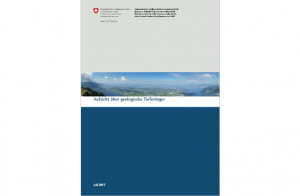Position paper defines supervision of deep geological repositories
In the new position paper, ‘Supervision of Deep Geological Repositories’, the Board and Executive Board of the Swiss Federal Nuclear Safety Inspectorate (ENSI) express their opinions on, amongst other things, the division of roles between ENSI and those subject to the supervision.
 After Stage 2 of the Sectoral Plan for Deep Geological Repositories (SGT), which is expected to be completed by the end of 2018, ENSI’s duties and responsibilities will increasingly change from supervision of the search for a location to supervision of the development and construction of a deep repository. In Stage 3 of the SGT the National Cooperative for the Disposal of Radioactive Waste, Nagra, will suggest sites for the deep repository and prepare general licence applications.
After Stage 2 of the Sectoral Plan for Deep Geological Repositories (SGT), which is expected to be completed by the end of 2018, ENSI’s duties and responsibilities will increasingly change from supervision of the search for a location to supervision of the development and construction of a deep repository. In Stage 3 of the SGT the National Cooperative for the Disposal of Radioactive Waste, Nagra, will suggest sites for the deep repository and prepare general licence applications.
ENSI will then have a number of new supervisory activities. Alongside checking of the location suggestions, this will in particular involve geological investigations during the drilling of exploratory boreholes, the investigation of underground structures and the further development of the storage concepts with a view to later implementation.
Five principles behind ENSI’s duties and responsibilities
ENSI’s duties and responsibilities in respect of nuclear waste disposal are explained based on five principles. In particular, the position paper details how the supervision of deep geological repositories imposes different requirements on ENSI than the supervision of nuclear installations does. Moreover, it deals with the attribution of roles between ENSI and the waste producers as well as communication with the stakeholders.
Principles for supervision of deep geological repositories
- Supervision: The requirements for supervision in connection with deep geological repositories differ significantly from the requirements for supervision of still operating nuclear installations.
- Guidelines: ENSI implements the legal requirements at guideline level and specifies protection targets, guiding principles and safety criteria.
- Allocation of roles to the waste producers: The waste producers develop solution proposals for the construction of deep geological repositories. ENSI’s main task is to access the suggested solutions at an expert technical level and in so doing to assess whether the protection targets, guiding principles and safety criteria are adhered to.
- Interaction with stakeholders: ENSI receives safety questions from all stakeholders at an early stage and considers safety-relevant aspects as part of its supervisory function.
- Legislation: If ENSI comes to the conclusion that changes to the legal provisions might be necessary, it will inform the responsible federal authorities.

